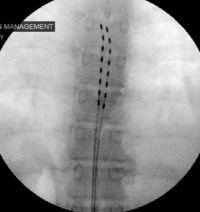
Case Report
Austin J Clin Case Rep. 2022; 9(5): 1260.
Dorsal Column Stimulation for the Treatment of Refractory Thoracic Radiculopathy: A Case Report
Sabia M¹*, Youssef D² and Calatroni R³
¹Division Head Pain Management, Associate Professor of Anesthesiology, Cooper Medical School of Rowan University, USA
²Pain Medicine Fellow, Cooper Medical School of Rowan University, USA
³Renato Calatroni, Cooper Medical School of Rowan University, USA
*Corresponding author: Michael Sabia, Division Head Pain Management, Associate Professor of Anesthesiology, Cooper Medical School of Rowan University, USA
Received: August 15, 2022; Accepted: September 12, 2022; Published: September 19, 2022
Introduction
Between 1996-2016, low back and neck pain expenditures amounted to $134.5 billion according to the Journal of the American Medical Association. Spinal Cord Stimulation (SCS) has been used with success in treatment of radiculopathy, peripheral nerve injury, diabetic neuropathy, failed back surgery syndrome, and complex regional pain syndrome. [1] Initially, low-frequency SCS was used and worked by activating large-diameter Ab fibers in the dorsal column, creating paresthesia stimulation at low frequency (120 Hz), high amplitude, and long duration. This was based on the Gate Control Theory so the low-rate pulsed energy applied at the certain vertebrae of the spine would activate A-beta fibers, which would gate out the nociceptive sensations carried by A-delta and C fibers. Then high-frequency stimulation was used with a frequency of 10,000 Hz, low amplitude, and short duration. This selectively activates inhibitory interneurons in the dorsal horn which suppresses wide dynamic range neurons, which are hyperactive in chronic pain. [2] High frequency stimulation has been found to be superior to low frequency in a RCT with 24 month data showing sustained relief [3].

Figure 1:
Medtronic created a new Differential Target Multiplexed (DTM) SCS after finding that SCS altered gene expression in the spinal cord and dorsal root ganglion. DTM SCS uses tailored high and low frequency signals to modulate glial cells and neurons to recalibrate their interactions. [4] We used DTM SCS to try and improve our patient’s chronic paraspinal thoracic pain through a 7 day implant trial and subsequent implantation.
Case
Patient CC is a 38 yo female who worked as a veterinarian tech and dog trainer. She first presented to the clinic with constant, severe thoracic back pain. She required her husband to try and alleviate the pain with 5 to 6 thoracic back massages every day. At work, she would need to hold down large dogs during their appointments, move them around as she trains them, and maintain tension on their leash so she exerts a lot of torsional energy through her thoracic spine. As they resisted, she would strain more and eventually began feeling a lot of paraspinal muscular pain. She began with physical therapy, oral medications, thoracic epidural injections, medial branch blocks, and radiofrequency ablations; none of which provided significant pain relief. She described the pain as burning, throbbin, and stabbing and rated the pain 8/10 on the Numeric Pain Rating Scale (NRS). She underwent a trial for a Medtronic spinal cord stimulator device to deliver DTM SCS. She was explained the risks: increased pain, nerve injury, infection, bleeding, hematoma, discitis (although low risk) and referred to Neurosurgery for implantation.
Fluoroscopic guidance was used to identify lumbar vertebral bodies, spinous process, pedicles, and disc spaces. Local was placed and then a 14 gauge tuohy needle was placed midway between spinous process and pedicle of the L2 vertebral body on right and left. Using a 45-60 degree angle, the needles were brought down to epidural space at L1 with fluoroscopic guidance. The epidural space was identified using the intermittent loss of resistance technique with saline. The spinal nerves T2, T3, T4, T5 were targeted and evaluated. Then a 45 cm Octrode lead was threaded in the cephalad direction maintaining midline and posterior position of epidural space.
Patient was then awoken from MAC anesthesia and leads were tested with the company representative. Pain and paresthesia overlap was achieved over the dermatomal segments of the patient’s pain. She performed a 7 day trial with the stimulator, with 50% or better improvement indicating permanent placement.
Discussion
While SCS has been used effectively to treat diverse chronic back conditions, DTM SCS is the first step in a new direction of intervention targeting the microenvironment within the spinal cord. With glial cells outnumbering neuronal cells 12:1, it is thought that targeting them with diverse waveforms can lead to improved benefit. [5] Our patient has intractable chronic pain that affects her day to day life as well as career. While SCS is commonly used in cervical and lumbar radiculopathy, it is not often implanted to treat paraspinal thoracic pain. Our patient tolerated the procedure, saw improvement in her 7 day trial, and received the implant. This indicates that there is a need for further investigation into whether thoracic SCS should be considered the main intervention considered after repeated treatment failures of more conservative measures.
References
- Dieleman JL, Cao J, Chapin A, Chen C, Li Z, et al. US Health Care Spending by Payer and Health Condition, 1996-2016. JAMA. 2020.
- Hamid B, Haider N. Spinal Cord Stimulator Relieves Neuropathic Pain in a Patient With Radiation-Induced Transverse Myelitis. Pain Pract. 2007; 7: 345- 7.
- Francio VT, Polston KF, Murphy MT, Hagedorn JM, Sayed D. Management of Chronic and Neuropathic Pain with 10 kHz Spinal Cord Stimulation Technology: Summary of Findings from Preclinical and Clinical Studies. Biomedicines. 2021; 9: 644.
- Vajramani GV. High Frequency (HF10) Spinal Cord Stimulation for Chronic Neuropathic Pain. Neurology India. 2020; 68: 337-339.
- Fishman M, Cordner H, Justiz R, Provenzano D, Merrell C, et al. Twelve- Month results from multicenter, open-label, randomized controlled clinical trial comparing differential target multiplexed spinal cord stimulation and traditional spinal cord stimulation in subjects with chronic intractable back pain and leg pain. Pain Pract. 2021; 21: 912-923.
- https://www.ncbi.nlm.nih.gov/pmc/articles/PMC7160773/